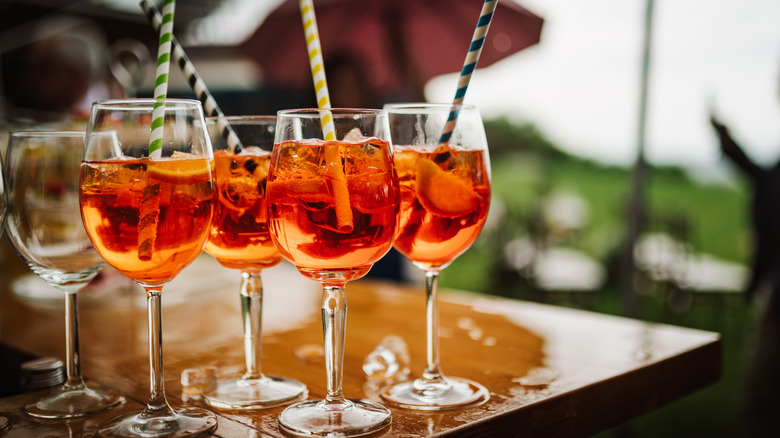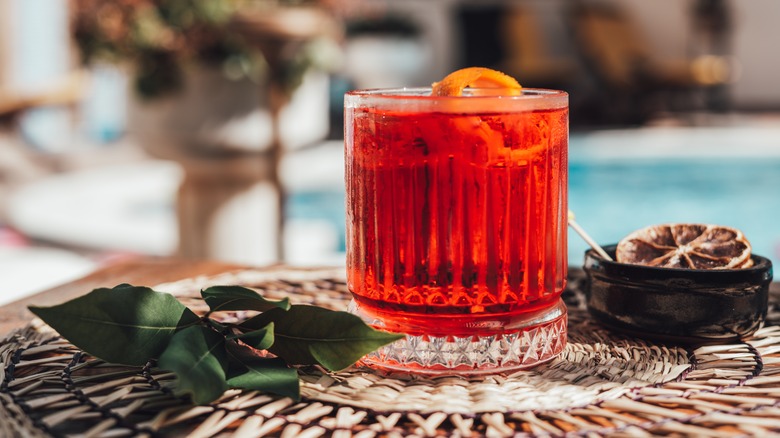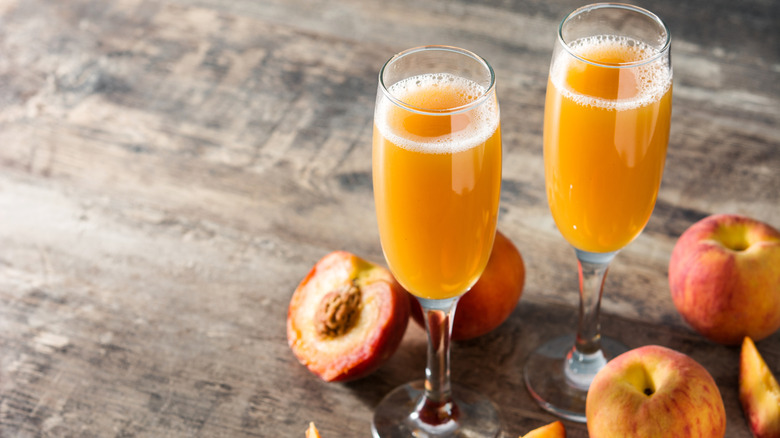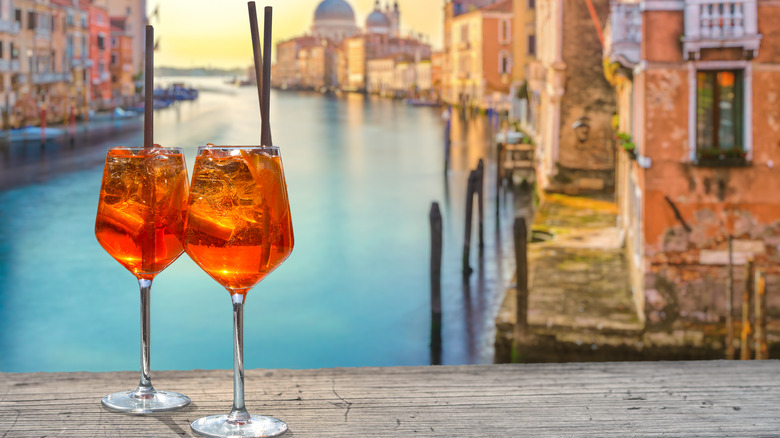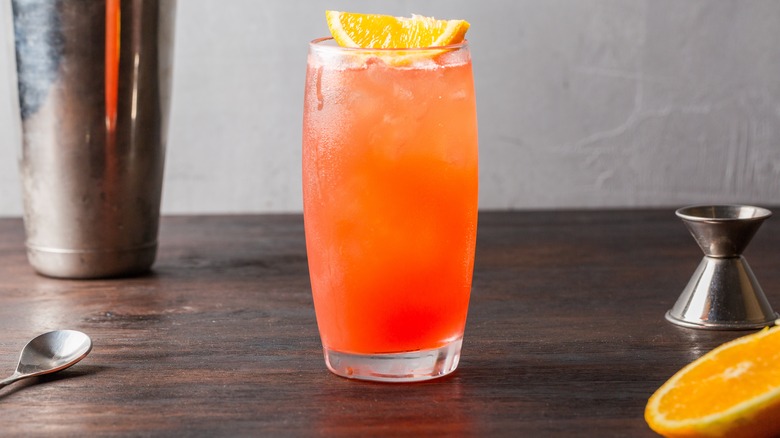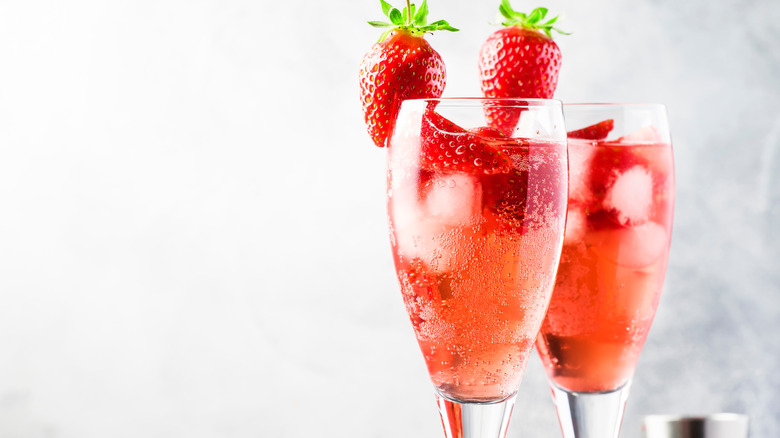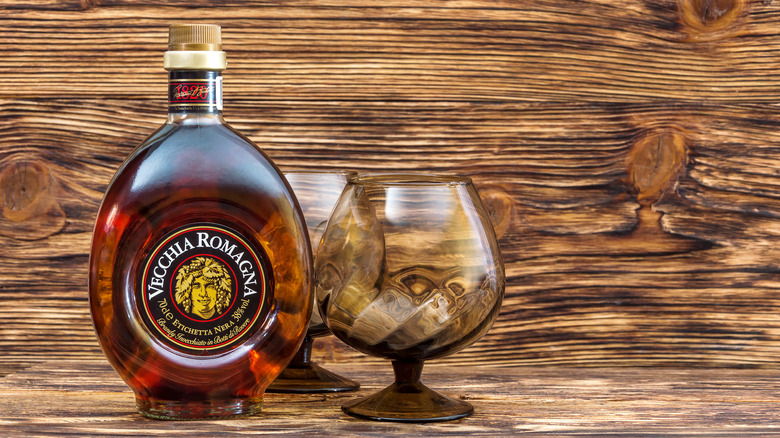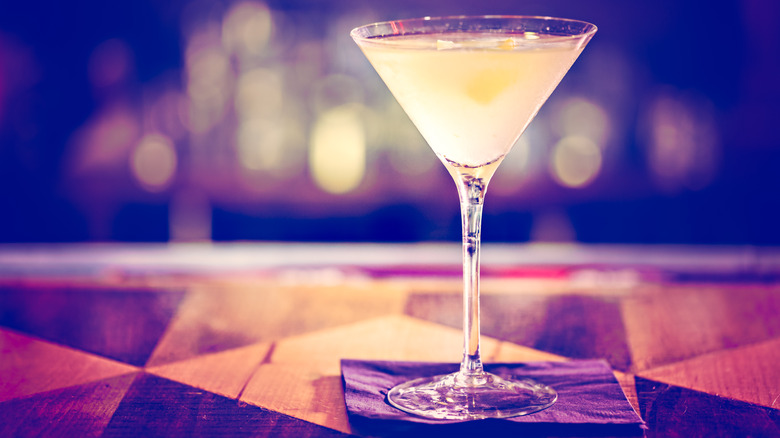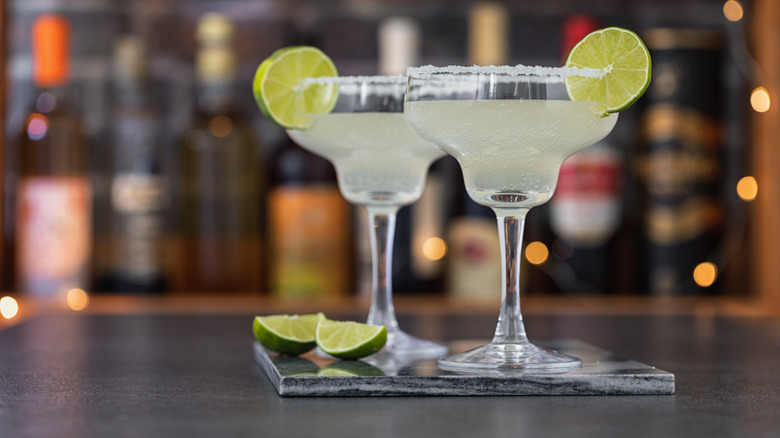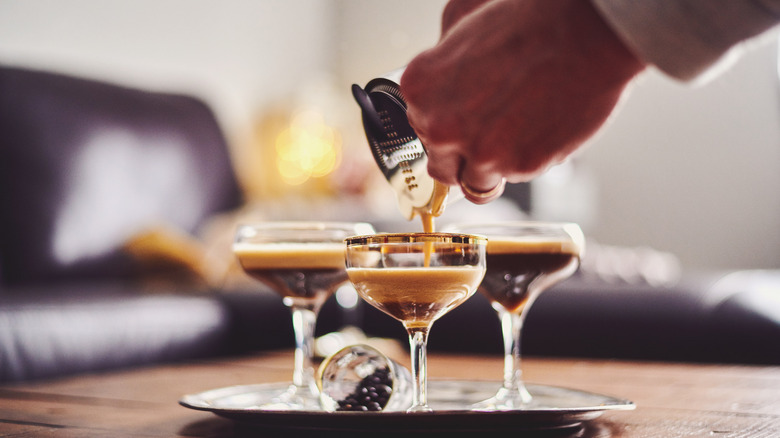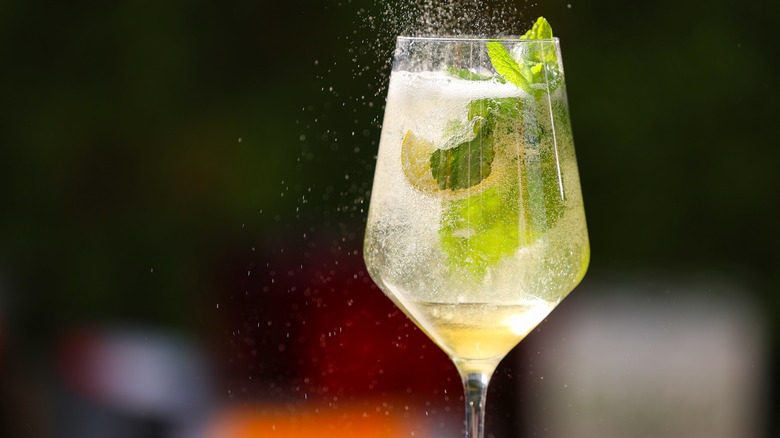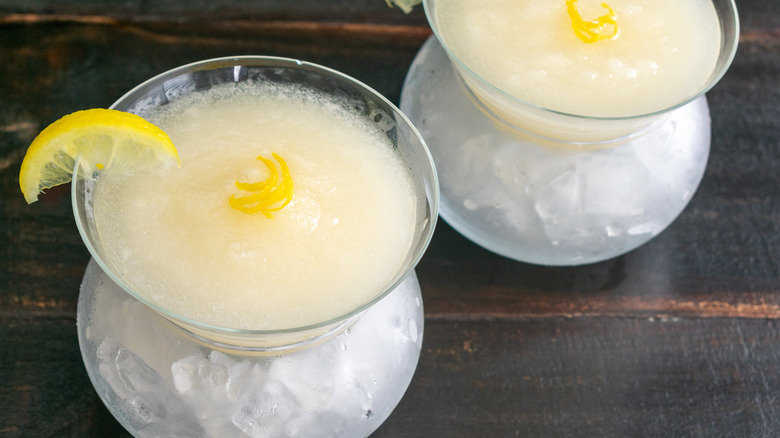11 Delicious Italian Cocktails You Need To Try ASAP
From the iconic spritz enjoyed al fresco in Venice to the zesty Amalfi martini savored along the sunny coastline, Italy's cocktail culture is as diverse as its landscapes. Drawing inspiration from an abundance of fresh fruit, flowers, and herbs, Italian liqueurs form the backbone of countless drinks consumed — and celebrated — worldwide, including brunch staples like the bubbly Bellini and spicy digestifs (served after meals) like sambuca.
Other classics like Campari and Aperol, with their bold flavors and vivid colors, are beloved fixtures in several cocktails served as aperitifs (before meals), while modern twists like the Hugo are giving tasty makeovers to traditional recipes. Even grappa, once maligned for its harsh taste and poor quality, is making a comeback.
With oodles of Italian cocktails to explore, we've curated a list of 11 flavorful favorites to kickstart your journey, complete with our picks for perfect food pairings. Each one tells a story of sun-drenched shores, lively piazzas, and centuries worth of ingenuity and inspiration. So, embrace la dolce vita and treat yourself to one of these delightful drinks today!
Negroni
The Negroni, a classic cocktail with a rich history, traces its origins back to 1919 in Florence, Italy, where Count Camillo Negroni requested that his bartender, Fosco Scarselli, add a twist to his usual Americano cocktail. Craving something with a stronger kick, he requested gin instead of soda water, and the Negroni was born.
This simple yet sophisticated cocktail comprises equal parts gin, sweet vermouth, and Campari, garnished with a fresh orange peel, and often served with a large ice cube. Its flavor profile is bold and complex, with spicy undertones from the Campari and a subtle sweetness from the vermouth. You can also give it a glow-up for the summer by ditching the gin and adding fizzy Prosecco instead.
If you're sticking with a classic Negroni recipe, just know it's one boozy bet. The Negroni boasts an average alcohol content of around 24% ABV (alcohol by volume), putting it on the stronger end of the cocktail spectrum, along with the martini, margarita, and Old Fashioned.
Because of the drink's robust flavors, it pairs well with rich and savory dishes, such as cured meats, cheeses, and salty snacks like olives or nuts. Whether enjoyed as an aperitif or a digestif, the Negroni oozes sophistication and refinement, making it a timeless favorite among discerning drinkers.
Bellini
The origins of the beloved Bellini — a simple but effervescent mix of peach puree and sparkling Prosecco — are just as enchanting as the drink itself. As detailed in the book, "Harry's Bar: The Life and Times of the Legendary Venice Landmark," this classic cocktail was dreamed up by Giuseppe Cipriani, the founder of Harry's Bar. This iconic establishment opened in 1931 in Venice and attracted famous artists, actors, and writers, like Ernest Hemingway and Truman Capote.
It was here that Cipriani drew inspiration from two things that would ultimately lead to the Bellini's creation: the glowing pink hues of 15th-century Venetian painter Giovanni Bellini and the white peaches that populate certain regions of Italy throughout the summer. In fact, the Bellini started out strictly as a seasonal cocktail due to the fruit's limited availability, until it was discovered that pureed peaches could be frozen and enjoyed year-round.
Today, a Bellini cocktail is the perfect refreshment on a warm summer's day and often finds its way to brunch tables as an alternative (or companion) to the mimosa. With the natural sweetness of peaches complementing the crispness of Prosecco, it pairs well with savory breakfast dishes, like this bacon, onion, and goat cheese quiche, or light appetizers like crostini topped with chevre and fresh herbs. When savoring your next Bellini, remember to lift your glass and cheer "Cin cin!", which is the informal way of saying "cheers" in Italian.
Spritz
The spritz stands as a classic Italian aperitif, often savored before or after meals or simply as a refreshing drink on its own. Recipes vary across Italy but typically comprise three parts bubbly Prosecco, two parts bitter liqueur (such as Aperol or Campari), and one part soda water.
Some stories date spritzes back to ancient Rome and Greece, where it was common to dilute wine with seawater, while more modern takes have it originating in the 1800s in northeastern Italy's Veneto region. The spritz actually owes its name to the German word "spritz," meaning "splash." The story goes that Austrian soldiers in the region found Italian wines to be too strong, so they weakened them with a "spritz" of water.
Today, the Aperol spritz ranks among the most popular spritz cocktails. It's a quick, easy mix, starting with 3 ounces of Aperol poured over a glass of ice with an orange slice nestled into it, then topped with 4 ounces of Prosecco and 1½ ounces of club soda. The citrusy, bright notes balance the herbal complexity of the Aperol, making for the perfect summer sipper. Or, you can change things up in the fall with this pear Aperol spritz. Because of its versatile flavor profile, the spritz pairs well with a variety of savory and salty foods, like a selection of cured meats and cheeses, or this tasty homemade Margherita pizza.
Garibaldi
Crafted with just two ingredients — Campari and freshly squeezed orange juice — the Garibaldi might seem almost too simple to appreciate. But when the bittersweet notes of the Campari meet the refreshing tang of citrus, it's not surprising why the Garibaldi has become a beloved choice among cocktail enthusiasts. Named in honor of Giuseppe Garibaldi, an esteemed Italian general and key figure in the unification of Italy, the simple combination of ingredients pays homage to Italy's rich history and diverse landscapes, with Campari symbolizing the north and orange juice reminiscent of the sun-kissed orchards of the south.
If you're not yet familiar with Campari, it's time to get acquainted. Invented in 1860 by Gaspare Campari in Novara, Italy, this prominent member of the Italian bitters family is made by distilling dozens of different aromatic and bitter herbs, roots, and spices — including rhubarb, orange peel, ginger, fennel, and star anise — into a high-proof neutral grain alcohol. Recognized for its striking red color and assertive bitter taste, it's a key component in classic cocktails like the Americano, Negroni, and Boulevardier, but we appreciate how the Garibaldi places Campari in the spotlight. Whether enjoyed as an aperitif to a leisurely meal or as a refreshing pick-me-up on a sunny afternoon, the Garibaldi is a solid bet for any occasion and pairs well with a range of light appetizers, seafood dishes, and chocolate or citrus-based desserts, like this chocolate orange tart.
Rossini
Think of the Rossini as the Bellini's sweet, spunky red-headed little sister. This fruity cocktail was crafted as an alternative to the classic peach-based Bellini, blending fizzy Prosecco with luscious fresh strawberries or strawberry puree, a touch of sugar or simple syrup, and lemon juice for added brightness.
The two drinks share quite a bit in common, including their birthplace. The Rossini came onto the scene in the 1940s at the iconic Harry's Bar in Venice, Italy, a little over a decade after Harry's founder Giuseppe Cipriani invented the Bellini. (This time, Cipriani drew inspiration from famous Italian opera composer Gioachino Rossini.)
While the Bellini was relished as a refreshing summer indulgence during peak peach season, the Rossini was traditionally savored as a springtime sipper, capitalizing on the brief availability of ripe strawberries in May and June. Thanks to imported fruits and the ease of using frozen puree, these cocktails are now relished year-round, often accompanying breakfast or brunch.
If you're making your own Rossini, muddle the strawberries to maintain their sweet-tart flavor. If you do blend them like Chef Jamie Oliver, gently fold the strawberry mix with ice and Prosecco instead of vigorously shaking or stirring to preserve the delicate balance of flavors and fizz.
The Rossini pairs well with light appetizers, like this classic bruschetta recipe or freshly seared scallops. It's also a delightful companion to summery strawberry shortcake or a dreamy decadent chocolate mousse cake, where each sip-bite combo tastes like a fizzy chocolate-covered strawberry.
Bologna Sour
You're likely familiar with the classic whiskey sour and the sweet-tart bourbon sour, but the Bologna Sour adds a splash of Italian flair, shaking things up with smooth Vecchia Romagna brandy. This bold spirit traces its roots back to Napoleon-era France but found its permanent home in Italy. According to the company's website, when Napoleon's regime fell, distiller Jean Buton took the family's secret recipes and headed to Italy in search of new adventures and better grapes. Touching down in Bologna in 1820, he set up a distillery that birthed the iconic Buton Cognac. Fast-forward to 1939, the company gave the liquor an Italian makeover, renaming it Vecchia Romagna Buton Brandy and jazzing up the bottle with its distinctive triangular shape.
The brandy has been an iconic addition to cocktails ever since, including the Bologna Sour, which combines the brandy with fresh lime juice and simple or agave syrup. Shaken and strained into a chilled tumbler, the drink then gets a boost of flavor, sophistication, and color with a drizzle of velvety red merlot wine. For the ultimate Italian sensory experience, pair your Bologna Sour with Italian cheeses, grilled fruits, roasted nuts, or a savory sandwich like this prosciutto-mozzarella panini with fig jam.
Amalfi Martini
Limoncello, the zestful darling of Italian culture and cuisine, has been tantalizing taste buds for well over a century, though its origins remain a bit of a juicy mystery. What we do know is that only sun-kissed lemons from a specific area of the Amalfi Coast can be used to craft authentic limoncello. Can't swing a trip to Italy? No worries! Pour yourself an Amalfi martini and channel those coastal vibes right at home. You can even try your hand at making your own limoncello.
Crafted with the sweet-tart limoncello, gin, freshly squeezed lemon juice, and a small sprig of aromatic mint (just enough for a subtle kick), this cocktail is sure to transport you to the sun-drenched shores of the Italian coast with its invigorating citrus scent, tangy flavor, and super smooth, velvety texture. While gin and vodka are often interchangeable in martini recipes, we like gin here for its more complex, herbal flavor, which contrasts the tartness of the lemons nicely. The Amalfi martini is a whole vibe on its own, but to enhance its lemony notes, pair it with dishes that also burst with fresh, citrusy flavors — like this lemony salmon risotto or a bright and sunny lemon lavender cake.
Grapparita
When it comes to liqueurs native to Italy, there's perhaps none more steeped in history and debate than grappa. Originating in the northern regions of Italy, grappa is a distinctive spirit crafted from the pomace, or grape residue, left over from winemaking. This includes the grape skins, seeds, and stems, which are distilled to create a potent and aromatic liquor. Grappa has evolved from its humble beginnings as a "peasant's drink" to a revered spirit appreciated by connoisseurs worldwide. Its production methods vary across different regions of Italy, resulting in a diverse range of flavors and characteristics.
Grappa is often enjoyed neat or on the rocks, but it's also a key ingredient in several cocktails. We like the Grapparita — a refreshing twist on the classic margarita that mixes the vibrant flavors of grappa with tart limoncello, fresh lemon juice, and frothy egg whites or aquafaba (foamy chickpea liquid, which makes a great addition to cocktails). Take care to strain your Grapparita twice — first with ice, strained back into the shaker, then without ice and strained into a chilled glass. The Grapparita's zesty lemon and assertive punch of grappa make it the perfect drink for tepid evenings spent on the patio or to complement equally bright seafood dishes, like this coconut-lime shrimp ceviche or these healthy fish tacos.
Sambuca espresso martini
When it comes to beloved Italian cocktails, you have your brunch go-tos and drinks that are perfect for patio chilling, but there's one that screams, "Let's end the night in style!" The sambuca espresso martini is our favorite indulgent nightcap, blending sweet licorice-flavored sambuca with smooth vodka, rich espresso, simple syrup, and decadent coffee liqueur. Top it off with a garnish of three espresso beans for extra pizazz and to pay homage to the traditional way sambuca is often served up in Italy.
Originating in the quaint town of Civitavecchia near Rome in 1851, sambuca has long been revered as a top-notch digestif, making its mark on countless cocktails, like the more modern espresso martini, as well as other classic mixers. With its spicy kick coming from star anise, sambuca might be an acquired taste for those who aren't fans of a distinctive licorice flavor, but it dances beautifully with the bitter punch of espresso, and the vodka swoops in to ensure a silky-smooth texture.
Pair it with Italian biscotti or decadent chocolate treats, like these dark-chocolate-covered caramels, to complement its rich profile and create a luxurious feeling that lingers on the palate. Whether enjoyed as a nightcap or a prelude to an evening of revelry, the sambuca espresso martini is perfect for moments of both indulgence and celebration.
Hugo spritz
Imagine strolling through the sun-kissed lanes of Italy and stumbling upon a charming café beckoning you inside for a refreshing cocktail. What do you order? If you find yourself in the South Tyrol region of northern Italy, famous for its majestic Dolomite Mountains, don't miss the chance to indulge in a Hugo spritz.
Crafted with bubbly Prosecco, fragrant elderflower syrup, soda water, and fresh mint leaves, this delightful drink is said to have originated in the early 2000s by bartender Roland Gruber. While its name's exact origins remain a mystery, legend has it that it was inspired by the beloved hotelier Hugo, celebrated for his warm hospitality. The Hugo is quickly gaining popularity as a charming alternative to the classic Aperol spritz and continues to offer a refreshing respite on a humid afternoon, regardless of your location.
Thanks to its clean, crisp flavor profile, the Hugo pairs well with light salads, such as this veggie antipasti Italian pasta salad, but can also cut through the richness of meat, like in this creamy, garlicky steak fettuccine recipe. Either way, this newcomer to the Spritz family exudes a whimsical charm that's hard to resist. So, if you're in the mood for something light, bubbly, and uniquely floral, don't hesitate to give the Hugo spritz a try.
Sgroppino
If you're a fan of frosé and haven't met a margarita you don't like, you'll no doubt love the Italian frozen cocktail, Sgroppino. This slushie-like concoction blends sweet-tart lemon sorbetto (sorbet) with smooth vodka and sparkling Prosecco, taking the edge off a sweltering summer day while doubling as a delicious dessert in a glass.
Its name originates from the Venetian word "sgropin," meaning to untie or loosen, hailing back to its role as a palate cleanser between courses. In fact, while it seems like a trendy new drink, the Sgroppino has roots dating all the way back to 16th-century Venice, where it was enjoyed by only the wealthiest households (i.e., those who had the means to make and maintain ice). Venetian nobility would serve freshly made sorbet with a splash of alcohol as a refreshing intermezzo to ease full bellies during lavish banquets and feasts. Over the centuries, it evolved into a beloved drink enjoyed by locals and visitors alike.
Today, it can be savored as a standalone treat (imagine yourself sipping one of these flirty, frosty drinks at a Venetian cafe overlooking the charming canals) or as a refreshing accompaniment to a leisurely meal with friends and family (go for dishes that will accentuate the drink's bright citrus notes, like succulent grilled shrimp skewers or linguine alle vongole). Salute!
